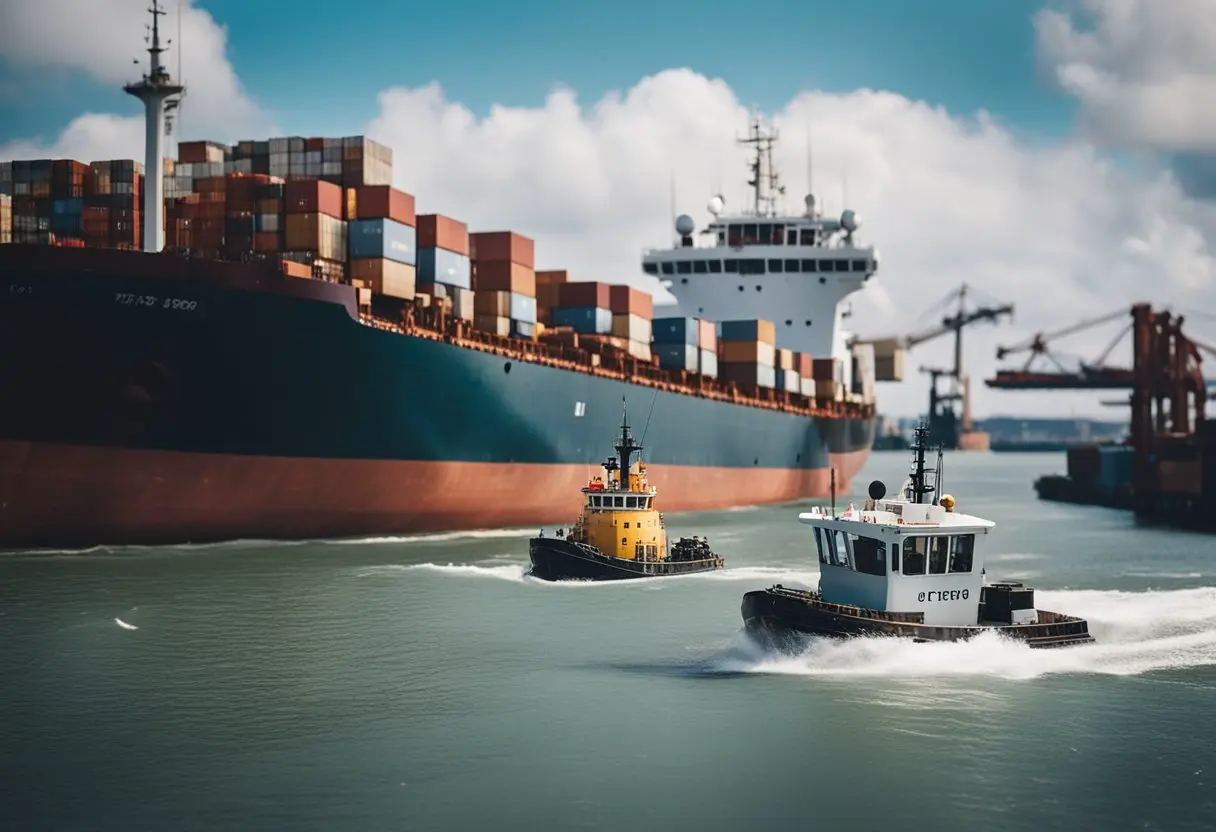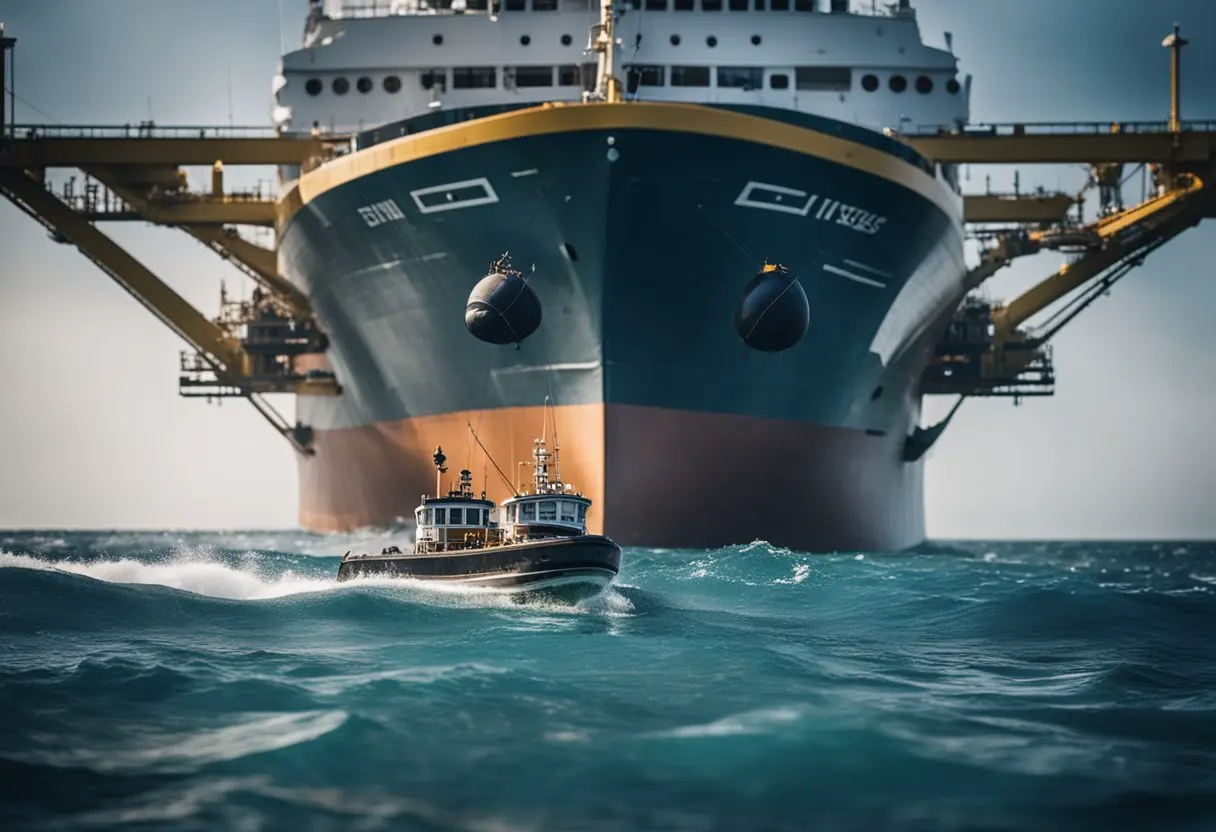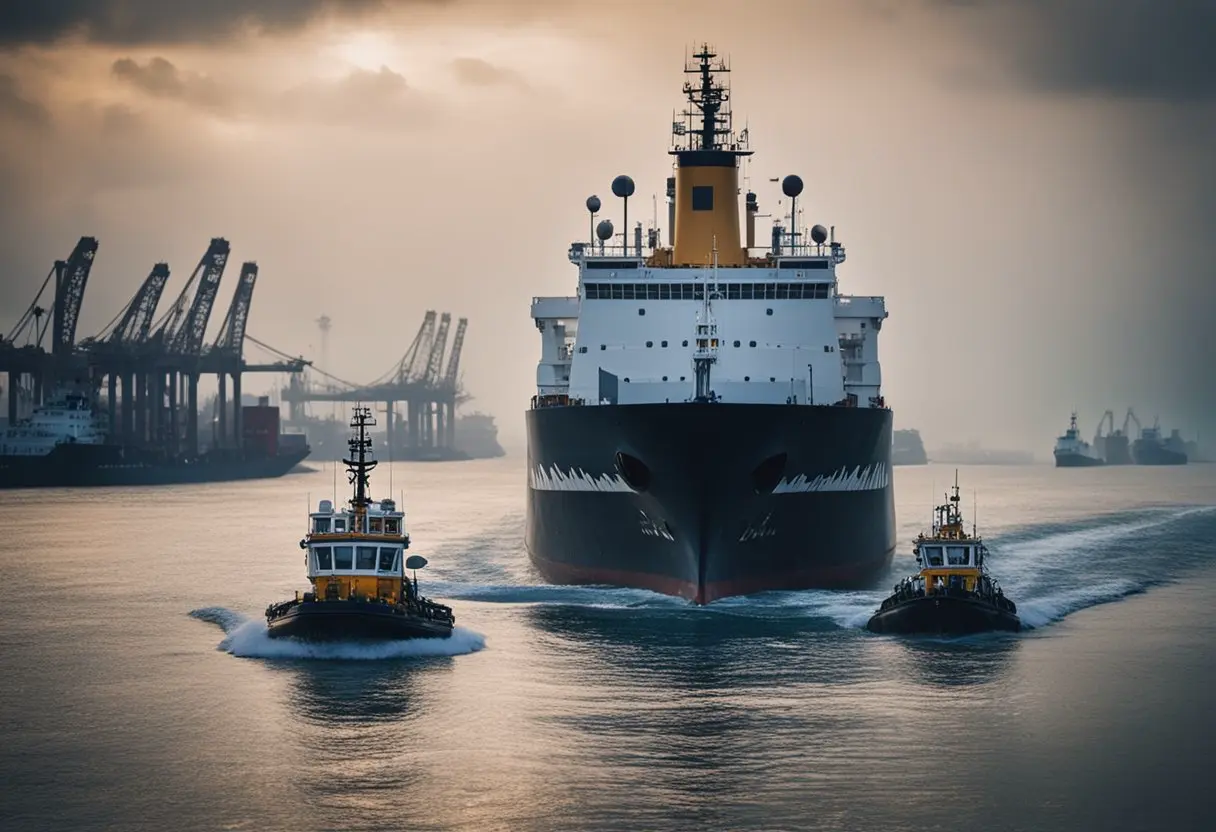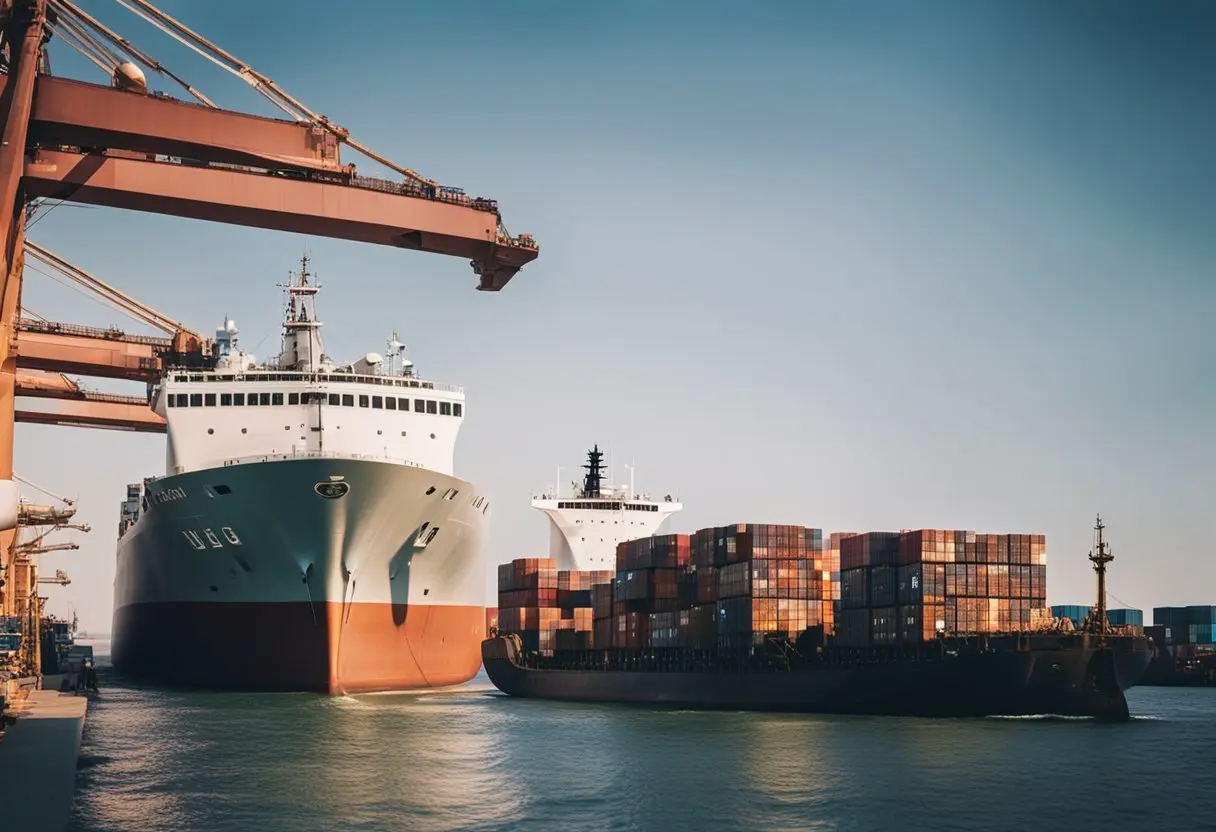How Small Tug Boats Move Huge Cargo Ships: Small tugboats are often overlooked when it comes to moving massive cargo ships. However, these small vessels play a crucial role in the shipping industry. Despite their size, tugboats are powerful enough to move cargo ships that are hundreds of times their weight.
Tugboats are designed to provide assistance to larger ships during docking and undocking, as well as maneuvering through narrow waterways. They are equipped with powerful engines and specialized equipment such as winches and towing cables, which allow them to push, pull, or guide larger vessels. Tugboats also use their weight and size to their advantage by positioning themselves strategically to provide the necessary force to move the ship.
The process of moving a cargo ship using a tugboat requires skill and experience. Tugboat captains must be knowledgeable about the size and weight of the ship, as well as the water currents, winds, and other environmental factors that can affect the maneuverability of the ship. They must also be able to communicate effectively with the crew of the cargo ship to ensure a safe and efficient operation.
The Role of Tugboats in Maritime Logistics

Tugboats play a crucial role in the maritime logistics industry, particularly in the movement of large cargo ships. These small but powerful watercraft are designed to perform a variety of functions, including towing or pushing barges and large ships.
The primary function of tugboats is to assist large ships in maneuvering through tight spaces, such as narrow canals, busy harbors, and congested ports. They help to ensure the safe and efficient movement of cargo ships, tankers, and other vessels by providing additional power and control during docking and undocking procedures.
Tugboats are also used to tow unpowered vessels from port to port. They can be attached to the bow or stern of the vessel, and their powerful engines can pull the vessel along the water. This is particularly useful for transporting large or heavy vessels that are unable to move under their power.
In addition to their towing capabilities, tugboats also play a vital role in shipbuilding and maritime construction. They help to move colossal structures and vessels during the construction process, ensuring that they are in the right position for welding, painting, and other tasks.
Overall, the role of tugboats in maritime logistics cannot be overstated. They provide essential support to the shipping industry, helping to ensure the safe and efficient movement of goods around the world.
Fundamental Mechanics of Small Tug Boats Operation
Tugboat Propulsion Systems
Tugboats are small and powerful boats that are designed to move large vessels around in tight spaces. They are equipped with powerful engines that provide the necessary thrust to move the ship. Most tugboats use diesel engines that are coupled to a gearbox, which in turn drives the propeller. The propeller is designed to provide maximum thrust, which enables the tugboat to move the ship efficiently.
In addition to diesel engines, some modern tugboats are also equipped with electric engines. These engines are more efficient and environmentally friendly than diesel engines. They are also quieter, which makes them ideal for use in residential areas.
Tugboat Steering Mechanisms
Tugboats are equipped with various steering mechanisms that enable them to maneuver the ship in tight spaces. One of the most common steering mechanisms is the rudder. The rudder is a flat plate that is attached to the stern of the boat. It is used to change the direction of the boat by deflecting the flow of water around it.
Another steering mechanism used in tugboats is the thruster. A thruster is a propeller that is mounted on the side of the boat. It is used to provide lateral thrust, which enables the boat to move sideways. This is particularly useful when maneuvering the ship in tight spaces.
In conclusion, tugboats are small but powerful boats that are designed to move large vessels around in tight spaces. They are equipped with powerful engines and steering mechanisms that enable them to maneuver the ship efficiently. The use of modern technology, such as electric engines, has made tugboats more efficient and environmentally friendly.
Tugboat and Cargo Ship Coordination

Communication Protocols
Clear communication between the tugboat and the cargo ship is essential for safe and efficient maneuvering. Before the operation begins, the tugboat captain and the cargo ship captain establish a communication protocol. The protocol includes the frequency and method of communication, the language used, and the terminology used to describe the maneuvering.
During the operation, the tugboat captain communicates with the cargo ship captain to ensure that the tugboat is in the right position and applying the right amount of force. The tugboat captain also keeps the cargo ship captain informed of any changes in the maneuvering plan.
Maneuvering Strategies
The maneuvering of a cargo ship with the help of a tugboat is a complex process that requires careful planning and execution. The tugboat captain uses a variety of strategies to move the cargo ship, including push-pull, side-by-side, and escort maneuvers.
In the push-pull maneuver, the tugboat pushes the cargo ship from one end while pulling it from the other end. This maneuver is used when the cargo ship needs to be moved in a straight line.
In the side-by-side maneuver, the tugboat moves alongside the cargo ship and applies lateral force to move it in the desired direction. This maneuver is used when the cargo ship needs to be moved in a tight space, such as a narrow canal or a harbor.
In the escort maneuver, the tugboat moves in front of or behind the cargo ship and guides it through a difficult passage. This maneuver is used when the cargo ship needs to be moved through a narrow waterway or a lock.
Overall, the coordination between the tugboat and the cargo ship is crucial for the safe and efficient movement of the cargo ship. By establishing clear communication protocols and using appropriate maneuvering strategies, the tugboat captain can ensure that the cargo ship is moved safely and efficiently to its destination.
Physics of Tugboat Assistance

Tugboats are small but powerful vessels that are used to move massive cargo ships in ports and canals. The physics behind tugboat assistance is based on the principles of force, momentum, and hydrodynamic effects.
Force and Momentum
Tugboats use force to move cargo ships by pushing or pulling them. The force generated by the tugboat is transferred to the ship through a towline. The towline is attached to the tugboat and the ship, and the force is transferred through tension in the line. The force generated by the tugboat must be greater than the resistance of the ship to move it.
Momentum is also important in tugboat assistance. The tugboat must build up momentum to move the ship. Once the tugboat has built up enough momentum, it can transfer that momentum to the ship to get it moving. The tugboat must also maintain its momentum to keep the ship moving.
Hydrodynamic Effects
Hydrodynamic effects play a crucial role in tugboat assistance. When a tugboat pushes or pulls a ship, it creates a disturbance in the water around the ship. This disturbance can create a force that can help or hinder the tugboat’s efforts to move the ship.
One of the hydrodynamic effects that can help tugboat assistance is the Bernoulli effect. The Bernoulli effect is the principle that as the speed of a fluid increases, its pressure decreases. When a tugboat moves through the water, it creates a low-pressure area behind it. This low-pressure area can help pull the ship along behind it.
Another hydrodynamic effect that can help tugboat assistance is the Coandă effect. The Coandă effect is the tendency of a fluid to follow a curved surface. When a tugboat pushes a ship, the water flowing around the curved hull of the ship can create a force that helps move the ship.
In conclusion, tugboat assistance is a complex process that involves the principles of force, momentum, and hydrodynamic effects. Tugboats use force to move ships, build up momentum to transfer to the ship and take advantage of hydrodynamic effects to help move the ship.
Safety Measures and Regulations
International Maritime Organization Standards
The International Maritime Organization (IMO) is a United Nations agency responsible for regulating international shipping. The IMO has established several standards and regulations to ensure the safety of tugboats and cargo ships. These standards include guidelines for the design, construction, and operation of tugboats, as well as safety protocols for towing operations and emergencies.
Tugboats must comply with the IMO’s standards for stability, propulsion, and maneuverability. They must also be equipped with appropriate safety equipment, such as life rafts, fire extinguishers, and communication devices. Additionally, tugboat operators must adhere to strict guidelines for towing operations, including proper communication with the cargo ship’s crew, use of appropriate towing equipment, and adherence to speed limits and other regulations.
Emergency Procedures
Despite the best efforts of tugboat operators and crew, emergencies can still occur during towing operations. To minimize the risk of accidents and ensure the safety of all personnel involved, the IMO has established emergency procedures that tugboat operators must follow in the event of an emergency.
These procedures include protocols for responding to fires, collisions, and other emergencies. Tugboat operators must also be trained in first aid and other emergency response procedures. Additionally, tugboat operators must have contingency plans in place for responding to emergencies in different weather conditions and other challenging situations.
Overall, the IMO’s standards and regulations play a crucial role in ensuring the safety of tugboats and cargo ships during towing operations. By adhering to these standards and following established emergency procedures, tugboat operators can help minimize the risk of accidents and ensure the safe transport of cargo around the world.
Technological Advancements in Tugboat Design

Tugboats have been an essential part of the maritime industry for centuries. Over the years, technological advancements have made tugboats more efficient, reliable, and powerful. In this section, we will discuss some of the most significant technological advancements in tugboat design.
Innovations in Tugboat Engines
One of the most significant technological advancements in tugboat design has been the development of more powerful and efficient engines. Modern tugboats are usually equipped with diesel-electric or hybrid engines that provide more power while consuming less fuel. These engines are also more environmentally friendly, producing fewer emissions than their predecessors.
Hull Design Improvements
Another area where technology has significantly impacted tugboat design is hull design. Modern tugboats are designed to be more hydrodynamic, reducing drag and increasing speed. They also have improved stability, making them more maneuverable in rough seas.
In addition to hull design, modern tugboats are also equipped with advanced navigation systems and communication equipment. These systems allow tugboat operators to navigate more safely and efficiently, reducing the risk of accidents.
Overall, technological advancements have significantly improved the efficiency, reliability, and safety of tugboats. As the maritime industry continues to evolve, we can expect to see even more innovations in tugboat design.
Environmental Considerations
Emission Controls
Small tugboats are powerful vessels that can move huge cargo ships, but they can also contribute to environmental pollution. To minimize their impact, tugboats are required to comply with strict emission controls, including the use of low-sulfur fuels and the installation of exhaust gas scrubbers. These controls help to reduce the amount of pollutants released into the air and water, improving the overall environmental performance of the shipping industry.
Sustainable Practices
In addition to emission controls, sustainable practices can also help to minimize the environmental impact of tugboat operations. For example, tugboat operators can use biodiesel or other alternative fuels, which produce fewer emissions than traditional fossil fuels. They can also implement best practices for waste management, such as recycling and proper disposal of hazardous materials.
Moreover, tugboat operators can take steps to reduce their energy consumption, such as by optimizing their routes and speeds, and by using energy-efficient technologies. These practices not only help to reduce the environmental impact of tugboat operations but also help to lower operating costs and improve the overall efficiency of the shipping industry.
FAQs About Tug Boats Move Huge Cargo Ships
What mechanisms enable tugboats to move larger vessels?
Tugboats are designed to move larger vessels by using a combination of techniques such as towing, pushing, and guiding. They use their powerful engines and propellers to create a force that can move a ship. The tugboat’s bow is designed to push against the ship’s stern, while the stern of the tugboat is designed to push against the ship’s bow. This allows the tugboat to create a force that can move the ship in any direction.
What kind of power do tugboats possess to assist heavy cargo ships?
Tugboats are equipped with powerful engines that provide the necessary power to move heavy cargo ships. The engines are typically diesel-powered and can generate a significant amount of horsepower. The amount of horsepower required depends on the size and weight of the ship being assisted. For example, a large cargo ship may require several tugboats with a combined horsepower of several thousand.
How do tugboats maneuver and position themselves to push or tow ships?
Tugboats use a combination of techniques to maneuver and position themselves to push or tow ships. They use their engines and rudders to turn and change direction. They also use lines and cables to attach to the ship and control its movement. The tugboat’s captain and crew work together to position the tugboat in the right location to provide the necessary force to move the ship.
Can tugboats operate effectively with all sizes of ships, including cruise ships?
Tugboats are designed to operate effectively with all sizes of ships, including cruise ships. The number of tugboats required depends on the size and weight of the ship being assisted. For example, a large cruise ship may require several tugboats to provide the necessary force to maneuver and dock the ship.
What are the specifications that make a tugboat powerful enough for ship assistance?
The specifications that make a tugboat powerful enough for ship assistance include its size, weight, horsepower, and bollard pull. Bollard pull is the force that a tugboat can exert on a stationary object such as a ship. The higher the bollard pull, the more powerful the tugboat. Tugboats are typically classified by their bollard pull, which can range from a few hundred pounds to several hundred thousand pounds.
How is the performance of a tugboat affected by the size and weight of a barge or ship?
The performance of a tugboat is affected by the size and weight of a barge or ship. The larger and heavier the ship, the more force is required to move it. This means that tugboats must be equipped with more powerful engines and have a higher bollard pull to effectively assist larger ships. The shape and design of the ship can also affect the tugboat’s performance, as some ships may be more difficult to maneuver than others.
Related Posts:
